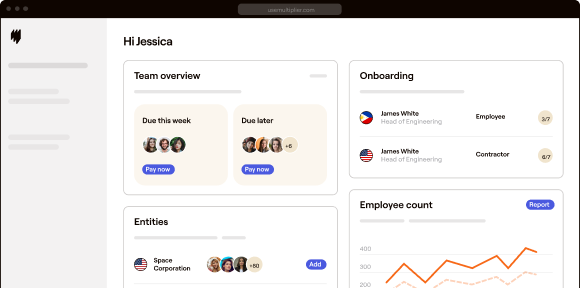As companies grow, managing payroll processes becomes increasingly complicated. Between the intricacies of tax regulations and complying with each country’s requirements, HR teams can lose hours and employee experience can suffer.
That’s why, in this article, we offer a guide to creating a solid payroll framework that is effective across borders. We also look at the software that can support you as you scale.
Understanding global payroll
Global payroll involves managing the onboarding and payment processes for employees and contractors across different countries. This requires adherence to each country’s specific employment conditions, tax requirements, and regulatory frameworks to ensure compliance and streamline payroll operations. Complex issues like data security, compliance issues, and fluctuating currency exchange rates also come into the picture.
Global vs. domestic payroll
Domestic payroll is the process of managing employee compensation within a single country while complying with local labor laws, tax policies, and benefits. It is a relatively simple process.
Global payroll, on the other hand, means you often have to account for various factors including:
- Managing and coordinating numerous payroll vendors across countries
- Managing compliance with complex regulations
- Losing visibility over the payroll process
- Ensuring accurate wage calculations and benefits administration
- Monitoring tax withholdings and meeting deadlines
- Managing payslips in local languages.
Challenges of managing global payroll
Let’s examine some common challenges in global payroll management and offer strategies to overcome them.
Compliance complexities
Understanding legislation is critical to ensuring compliance on a global scale. For instance, say a company X hired people from India, Brazil, and Germany… These countries have varying regulatory requirements in terms of minimum wage laws, currencies and exchange rates, employee classification mandates, tax regulations, compulsory employee benefits, and methods of payment. It’s crucial for X to stay on top of things to expand its operations into new territories, but this can be complex and time-consuming.
This is where an Employer of Record solution comes in, acting as the legal employer for a company with a global team and taking on the burden of compliance. In this case, the payroll process will be completely outsourced and managed in line with local laws.
Administrative costs
Setting up foreign payment entities and paying for payroll vendors in several regions can prove costly. And the amount of time your team has to spend researching compliance and navigating these solutions can also add to your overheads.
With a global payroll solution though, you can manage your payroll across countries in one place. Multiplier, for example, allows you to retain control over your payroll process in 150 countries while outsourcing time-consuming multi-country tax, benefits, and compensation calculations.
System integration issues
Integrating diverse payroll systems with tools such as HRMS, invoicing, and expense management can lead to compatibility issues and data synchronization problems. What’s more, splitting data between several systems can pose a security risk.
Employing a unified global payroll software solution can streamline this process. For instance, with Multiplier, organizations can gain access to a one-stop source for payroll processing that seamlessly integrates with a wide range of HR and accounting, software. This creates a unified ecosystem that eliminates data duplication, reduces manual effort, and enhances accuracy.
Employee confidentiality
To protect your international employees’ payroll data, you need to ensure that every system you work with is compliant with the likes of GDPR and CCPA as well as any regional data regulatory framework relevant to your company.
A strong international payroll system does this for you.
Untimely or inaccurate payments
Delayed payroll disbursement can demoralize employees, tarnish an organization’s image, and even lead to penalties. Automated payroll systems can prevent delays and ensure consistency.
With Multiplier, businesses get much more than just automation. They can preview and approve payroll data before finalizing it, integrate with Multiplier’s time off, timesheets, and expenses module, and send payslips in the local language. You can also access dedicated 24/7 customer support teams to address queries and on-ground experts to help you steer clear of compliance issues.
Global payroll process: A step-by-step guide
Global payroll management involves several critical steps:
Data collection and entry
The first step involves gathering essential employee information such as working hours, compensation tax details, etc. In countries like the US, this data is collected through a W-4 form, while other countries have their own unique requirements and documentation. Platforms such as Multiplier simplify this by centralizing the data collection and documentation processes.
Gross pay calculations
Once the data is collected, the next stage is to calculate the gross pay for each employee — this is the total amount before deductions. For international employees, this figure must be converted to the relevant currency. Companies also have to ensure that currency conversion rates are up-to-date and comply with local exchange rate regulations to avoid financial loss during the conversion process.
Tax filing and payment
Payroll tax deductions will then be made in line with local regulations. The process of paying these will differ from country to country, and companies need to maintain all records of payment to ensure compliance in each location.
Net pay calculation and payroll processing
After taxes have been deducted, the net pay is calculated and distributed to the employees. In addition to salary, they will also receive any relevant benefits such as health insurance, retirement plans, and stock options. Payments are usually made by either check or direct payment deposit depending on preference and local practice.
Additional considerations beyond these steps:
Be sure to pay attention to the following throughout the payroll process.
Managing cross-border payroll taxes and social security contributions
Factors that come into play when administering cross-border payroll taxes and social security contributions are:
- A strong understanding of the social security and taxation policies of respective countries
- Harmonization with comprehensive payroll systems that can streamline and automate complex processes
- Ensuring an up-to-date documentation status with everything in place, such as A1 coverage certificates
- Keeping employees abreast of their tax liabilities and accountabilities
Currency conversion
Accurately dispensing salaries based on the employees’ home currency is mission-critical. You can forestall challenges by tracking conversion rates and teaming up with robust global payroll providers that help facilitate multi-currency payment conversions.
Compliance with international tax laws:
It’s important to follow each country’s specific regulations, although doing so might be extremely difficult. Using payroll software solutions for tax assessments and returns, staying informed about changing legislation, and working with local specialists are all great steps to take.
Processing payroll: Timeframes and fees
Processing international payroll may extend over a period of 1 to 5 days, contingent on several variables. For instance, payroll processing timeframes and duration vary in different continents like Europe and North America. Similarly, the direct deposit timelines are subject to multiple factors, such as:
- Payment method: Some payment mediums, like SWIFT, may take up to 5 days for global payments.
- Type of financial institutions: The size and kind of financial institution involved can impact the duration significantly.
- Deposit timing: The day of the week scheduled for deposits can also affect timelines. For instance, payroll processing scheduled on Fridays or before holidays may experience delays.
Factors that can delay payroll processing
To avoid harming the employee experience, businesses must proactively identify and mitigate payroll delays. Here are some common issues that impact payroll to look out for:
Manual efforts
Relying on manual payroll processes can often lead to prolonged delays. Automating payroll systems can drastically reduce the time needed for calculations and approvals.
Managing different solutions and platforms
A major contributor to delays in international payroll processing is the coordination of local vendors, which often involves the complexities of managing various solutions and platforms.
Holidays
On certain days, like public holidays or the weekend, most banks, credit unions, and other financial institutions don’t operate. If payday falls on such days, payroll processing is likely to be delayed.
Last-minute updates
Last-minute changes in data regarding new hires, bonuses, extra work hours, etc. can enhance the staff’s workload, leading to reapprovals and reassessments that cause further delays.
Overlooked steps
Incomplete documentation and mistakes in employees’ data can cause delays further down the line.
Payroll filing and compliance: Best practices
Maintaining compliance is foundational to effective payroll management. Listed below are some of the best practices that can help businesses tick all the boxes off their payroll process checklist:
Plan and track key deadlines
Keeping up with filing and payroll processing deadlines is of utmost importance. Make sure that deadlines are structured so as to keep the other interested parties in the know.
Manage time and attendance effectively
Accurate stock of time frame is essential to avoid payroll discrepancies. A dedicated tracking system enables correct payroll calculations and prevents errors like overpayments or misallocation of overtime.
Classify workers correctly
One major problem involves employing workers and calling them independent contractors mistakenly. Proper worker classification keeps businesses from facing retribution and owing tax.
Payroll HR: Integrating payroll with Human Resources
Managing payroll and HR functions through disconnected systems can often hinder productivity and lead to errors. Here’s how businesses can reap the benefits of integrated HR and payroll software:
Better accuracy and efficiency
Integrating HR and payroll solutions helps avoid errors largely caused by managing separate databases. With a single unified system, the need for manual entry of data is almost eliminated, leading to more effective payroll as well as HR processes.
Improves reporting
A combined HR payroll system can enable the in-house teams to tap into an extensive repository of insights and information to create meaningful, data-driven reports. Multiplier’s global payroll solution, for example, offers insights into salary disbursements, statutory filings, and cost analysis based on various parameters such as headcount, cost center, and department.
Enhanced security
Employers can rely on an integrated payroll and HR system to securely manage sensitive data, including GDPR concerns. This diminishes the chances of data duplication and goes further in preventing breaches.
Effective payroll management for a global workforce
To maintain compliance and efficiency in your global payroll processes, you need a solid global payroll solution. Multiplier can help consolidate your entire team’s payroll needs into a single platform, eliminating the need for multiple providers and cumbersome spreadsheets.
No matter where your team is located, we’ll manage their payment end-to-end, taking into account any necessary adjustments. Meanwhile, with seamless integrations and customizable reports, you can retain control over the process.
Pay global teams effortlessly. Talk to one of our experts today.
FAQs
Q1. How long does it take for payroll to process?
Typically, with the aid of automated systems, payroll processing gets completed within a period of one to five business days, with a majority of employees being paid within a few days after the pay period is over. Some other factors that also affect the processing timelines are the method of payment, the size of the organization, and the complexity of the process.
Q2. What are the responsibilities of a payroll manager?
Payroll managers are responsible for processing payroll, maintaining records, managing payroll staff, ensuring compliance, generating reports, reviewing policies, addressing payroll queries, managing projects, performing payroll reconciliations, and coordinating with third-party payroll vendors.
Q3. How do on-demand payroll systems work?
On-demand payroll systems operate automatically. Employees can access their earnings by logging into their company’s financial accounts.
Q4. What are the most common payroll mistakes, and how can they be avoided?
Some of the most common payroll mistakes include tax negligence, employee misclassification, poor records maintenance, overpayments and underpayments, and missed tax deadlines. To rectify these errors, ensure proper record-keeping and use a global payroll solution to stay on top of compliance and view all data in one place.







